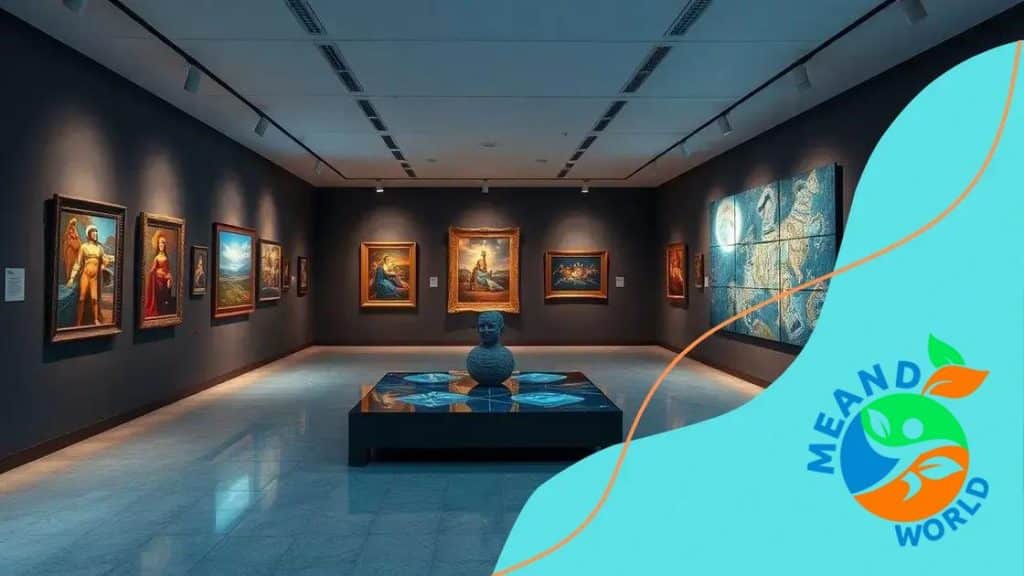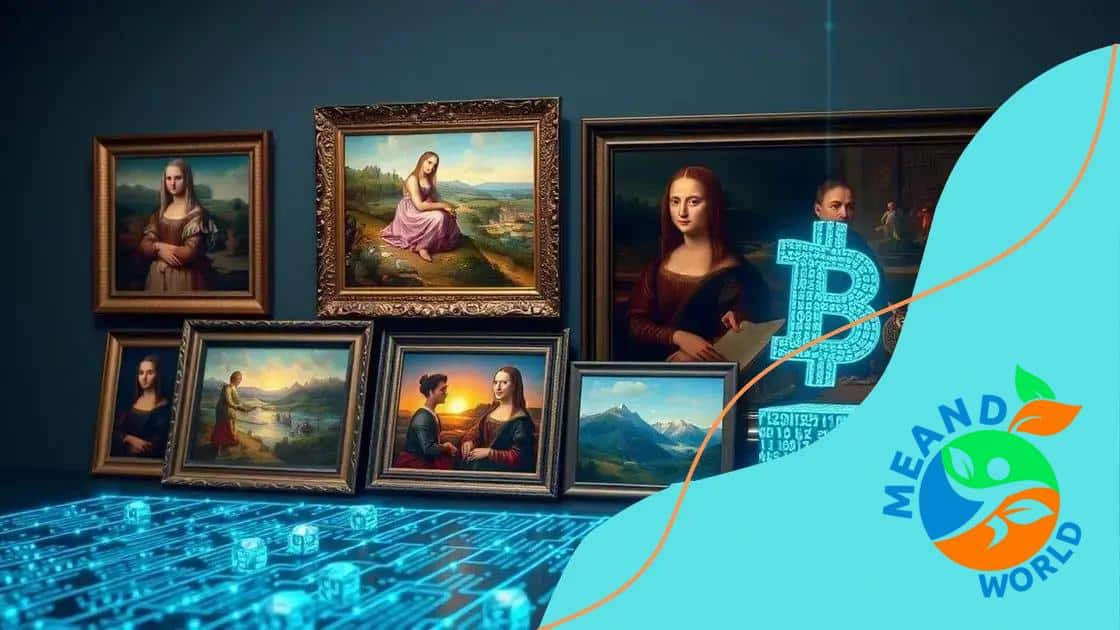How blockchain is transforming the art and collectibles market

Anúncios
How blockchain is transforming the art and collectibles market by enhancing authenticity, providing transparent provenance, and enabling direct sales between artists and buyers through secure digital transactions.
How blockchain is transforming the art and collectibles market is a question that many are asking as this technology reshapes our understanding of ownership and value. Just think, what if art pieces could be traded with absolute security and transparency?
Anúncios
Understanding blockchain technology in art
To truly grasp how blockchain technology is revolutionizing the art world, it’s essential to understand its core principles. Blockchain is a decentralized digital ledger that securely records transactions across many computers. This means that no single entity controls the data, making it resistant to tampering or fraud. In the context of art, blockchain ensures transparency and authenticity, which are crucial for both artists and collectors.
Anúncios
What Is Blockchain?
Blockchain technology allows digital information to be distributed but not copied. This crucial feature is what enables artists to create unique digital assets, primarily through Non-Fungible Tokens (NFTs). Each NFT is tied to a specific piece of digital art, which acts as proof of ownership stored securely in the blockchain.
Key Features of Blockchain in Art
- Provenance Tracking: Artists and buyers can trace the origin of a piece, ensuring it isn’t counterfeit.
- Smart Contracts: These self-executing contracts facilitate transactions automatically when conditions are met, streamlining sales.
- Royalty Payments: Artists can earn royalties on future sales of their work, ensuring they benefit from increases in value.
Moreover, blockchain enhances the collectors’ experience. With its secure ledgers, buyers can purchase art with confidence, knowing that they own a legitimate piece. This technology can change how galleries and auction houses operate as well, as it can simplify and secure transactions, making art more accessible.
Understanding blockchain’s role in art goes beyond its technical definition. It’s transforming the relationship between artists and collectors, fostering a community that values security and transparency. With new possibilities emerging, the art market can expect a shift towards digital ownership.
The rise of digital art and NFTs
The rise of digital art marks a significant shift in the art world. With the advent of online platforms and advanced technology, artists can create and share their work globally. Today, many creators are turning to digital formats, producing artwork that can only exist in a digital space. This transformation is not just about style; it’s changing the very essence of how art is viewed and valued.
Understanding NFTs
Non-Fungible Tokens (NFTs) play a crucial role in the digital art movement. Unlike cryptocurrencies like Bitcoin, which are interchangeable, NFTs are unique digital tokens that verify ownership of a specific piece of art. This uniqueness gives NFTs their value and allows artists to sell their work confidently.
Benefits of Digital Art and NFTs
- Accessibility: Digital art reaches a broader audience, allowing more people to engage with and purchase art.
- Empowerment for Artists: Artists can sell their work directly to buyers without galleries or intermediaries.
- New Revenue Streams: NFTs enable artists to earn royalties on future sales of their work.
This new medium has spurred creativity, allowing artists to experiment with different forms and styles. From animated graphics to digital illustrations, the possibilities are endless. Moreover, collectors are increasingly interested in owning digital assets, leading to a booming market for NFTs.
As the digital art landscape continues to expand, it’s essential to recognize its impact on traditional art markets. Galleries are starting to showcase digital artworks, while auctions for NFTs generate significant interest and high sales. This fusion of art and technology creates exciting opportunities for both artists and collectors, reshaping the way we perceive value in the art world.
How blockchain enhances provenance and authenticity

Blockchain significantly enhances provenance and authenticity in the art world. By providing a secure and transparent method to track the history of an artwork, blockchain ensures that both artists and collectors can verify the origins and ownership of a piece. This feature is crucial in combating art forgery, which has plagued the industry for decades.
The Role of Provenance
Provenance refers to the documented history of an artwork, tracing its ownership from its creation to the present. With blockchain technology, each transaction, ownership transfer, and exhibition of the artwork can be recorded permanently and securely. This creates a clear and accessible history that potential buyers can trust.
Ensuring Authenticity
- Immutable Records: Once data is recorded on the blockchain, it cannot be altered or deleted. This quality helps maintain the integrity of the artwork’s history.
- Digital Certificates: Each piece of art can be associated with a unique NFT that acts as a digital certificate of authenticity, proving that the asset is genuine.
- Reduces Fraud: By tracing an artwork’s history reliably, blockchain helps prevent fraud and misrepresentation in the art market.
Moreover, artists benefit from enhanced control over their creations. They can attach to their works a detailed history of ownership and exhibitions, making their art more valuable in the eyes of collectors. This newfound transparency leads to increased trust among buyers, fostering a healthier marketplace.
As the art industry continues to embrace technology, the importance of provenance and authenticity will only grow. Blockchain is paving the way for a future where art can be freely traded while ensuring that each piece’s history and legitimacy are clearly documented and secured.
Impact of blockchain on art sales and marketplaces
The impact of blockchain on art sales and marketplaces is profound and far-reaching. As this technology continues to gain traction, it introduces new ways for artists to connect with buyers while enhancing the overall experience in art transactions. One of the most significant changes is the shift toward transparency, allowing all parties involved to verify the integrity of their purchases.
Changing the Marketplace Landscape
Blockchain technology opens up a global market for artists and collectors alike. No longer confined to traditional galleries, artists can sell their work directly to buyers through online platforms that utilize blockchain. This direct access means lower fees and increased profits for creators.
Enhancements in Sales Processes
- Smart Contracts: These are self-executing contracts with the terms of the agreement directly written into code. They facilitate automatic payments once conditions are met, streamlining the transaction process.
- Reduced Intermediaries: By minimizing the need for middlemen, blockchain reduces costs and fosters a more efficient buying experience.
- Global Reach: Artists can sell their work to anyone around the world, breaking down geographical barriers.
Additionally, buyers are more confident in their purchases due to the verified nature of transactions. Each piece of art can be linked to a unique NFT, which provides a secure proof of ownership. This innovation encourages new buyers to enter the market, knowing they are making safe investments.
As digital marketplaces evolve, the integration of blockchain is setting new standards for security and trustworthiness in art sales. Platforms are emerging that focus specifically on blockchain-enabled art trading, further enhancing the accessibility and appeal of art collecting.
Future trends in art and collectibles with blockchain
The future of art and collectibles is set to change dramatically thanks to blockchain technology. Artists and collectors alike are beginning to understand the potential of digital tools and the benefits they offer. With the rise of NFTs and other digital formats, the traditional art market is evolving swiftly.
Emergence of New Platforms
New online platforms will continue to emerge, making it easier for artists to showcase and sell their work directly to consumers. These platforms will leverage blockchain to ensure secure transactions and clear ownership. This transition allows more artists to gain exposure without the constraints of traditional galleries.
Increased Focus on Digital Collectibles
- Expansion of NFT Market: As more individuals recognize the value of digital collectibles, the NFT market is expected to grow significantly.
- Integration with Virtual Reality: Imagine experiencing art in immersive virtual environments. This integration will likely enhance how collectors engage with artworks.
- Community-Driven Art: Future trends may include community-driven projects, where collectors participate in the creation and funding of art initiatives.
Moreover, artists will have greater control over their work, setting their terms and conditions without needing a middleman. This empowerment will foster creativity, allowing artists to experiment with digital formats while maintaining ownership rights.
As technology continues to advance, collectors will benefit from greater access to diverse art forms. They will have the ability to interact with artists and other collectors more directly, creating a more vibrant and interconnected art community.
FAQ – Frequently Asked Questions about Blockchain in Art and Collectibles
How does blockchain ensure the authenticity of artwork?
Blockchain creates an immutable record of an artwork’s ownership and history, making it easy to verify its authenticity.
What are NFTs and how do they relate to digital art?
NFTs, or Non-Fungible Tokens, are unique digital assets that represent ownership of a specific piece of digital art on the blockchain.
Can artists directly sell their work using blockchain technology?
Yes, blockchain allows artists to sell their work directly to buyers, eliminating the need for intermediaries like galleries.
What impact does blockchain have on art marketplaces?
Blockchain enhances transparency and security in art transactions, which boosts trust among buyers and sellers in the marketplace.





